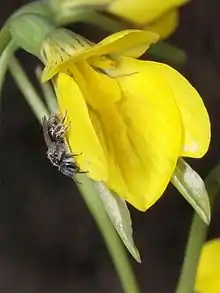| Little golden moths | |
|---|---|
 | |
| Diuris basaltica with the bee Lasioglossum cognatum | |
| Scientific classification | |
| Kingdom: | Plantae |
| Clade: | Tracheophytes |
| Clade: | Angiosperms |
| Clade: | Monocots |
| Order: | Asparagales |
| Family: | Orchidaceae |
| Subfamily: | Orchidoideae |
| Tribe: | Diurideae |
| Genus: | Diuris |
| Species: | D. basaltica |
| Binomial name | |
| Diuris basaltica | |
| Synonyms[1] | |
| |
Diuris basaltica, commonly known as little golden moths,[2] or small golden moths[3] is a species of orchid which is endemic to Victoria. The species has suffered a catastrophic reduction in range and distribution as a result of clearing for agriculture, then by urban expansion until only about four hundred plants remain in the wild.
Description
Diuris basaltica is a tuberous, perennial herb 60–150 mm (2–6 in) tall with between three and seven linear, green leaves, each 30–100 mm (1–4 in) long and 1–2 mm (0.04–0.08 in) wide. There are up to three bright golden yellow to orange-yellow flowers, 15–20 mm (0.6–0.8 in) wide with a few dark streaks. The flowers often do not open widely and lean downwards. The dorsal sepal is 7–12 mm (0.3–0.5 in) long, 6–8 mm (0.2–0.3 in) wide and more or less erect. The lateral sepals curve downwards, 10–16 mm (0.4–0.6 in) long, 1.5–2.5 mm (0.06–0.1 in) wide. The ear-like petals are egg-shaped, 6–10 mm (0.2–0.4 in) long, 3.5–6 mm (0.1–0.2 in) wide with a green stalk, 3–4 mm (0.1–0.2 in) long. The labellum has three lobes, the lateral ones small, wedge-shaped and pimply. The middle lobe is broadly egg-shaped, 7–10 mm (0.3–0.4 in) long, 7–11 mm (0.3–0.4 in) wide with two widely separated ridges near the base and a central ridge extending almost to its tip. Flowering occurs from September to October.[2][4]
Taxonomy and naming
Diuris basaltica was first formally described in 2006 by David Jones and the description was published in Australian Orchid Review.[5] The specific epithet (basaltica) is a Latin word referring to the soils derived from basalt in which this orchid grows.[6]
Distribution and habitat
Little golden moths grows with kangaroo grass on eastern parts of the basalt plain to the west of Melbourne. The orchid once had a wider distribution on the volcanic plains of south-western Victoria but has suffered a catastrophic decline, firstly due to clearing of its habitat for agriculture and later by urbanisation.[2][3][6]
Conservation
Diuris basaltica only survives in three populations, the largest of which includes about 400 plants on private property. Only five plants are conserved in a reserve and another two plants occur in the third population on private land. The main threats to the species are habitat loss, disturbance to or destruction of plants, grazing, weed invasion and altered fire regimes. The species is listed as "endangered" under the Victorian Flora and Fauna Guarantee Act 1988 and the Australian Government Environment Protection and Biodiversity Conservation Act 1999.[3][4]
References
- 1 2 "Diuris basaltica". Australian Plant Census. Retrieved 23 June 2023.
- 1 2 3 Jones, David L. (2006). A complete guide to native orchids of Australia including the island territories. Frenchs Forest, N.S.W.: New Holland. pp. 125–126. ISBN 1877069124.
- 1 2 3 Backhouse, Gary; Lester, Karen. "National Recovery Plan for the Small Golden Moths Orchid Diuris basaltica" (PDF). Australian Government Department of the Environment. Retrieved 5 March 2018.
- 1 2 Jeanes, Jeff. "Diuris basaltica". Royal Botanic Gardens Victoria. Retrieved 5 March 2018.
- ↑ "Duiris basaltica". APNI. Retrieved 5 March 2018.
- 1 2 Jones, David L. (2006). "New taxa of Australian Orchidaceae". Australian Orchid Research. 5: 75–76.
